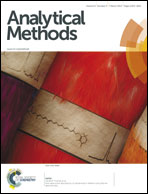A turn-on fluorescein spirolactam derivative as a high selective fluorescence probe for detection of silver ion(i) in water†
Abstract
In this paper, a fluorescein spirolactam derivative, ((E)-3′,6′-dihydroxy-2-((thiazol-2-ylmethylene)aminospiro[isoindoline-1,9′-xanthen]-3-one) (HTMIX), was synthesized and used as a turn-on fluorescence probe for the detection of silver ion in aqueous solution. The binding mechanism of HTMIX to Ag+ was evaluated using the Hildebrand–Benesi equation based on a 1 : 1 binding model with R = 0.9993. And the influence of sixteen common metal ions on the fluorescence intensities of HTMIX–Ag+ solution was investigated in detail. The results show that HTMIX exhibited high selectivity towards Ag+ in a 20% ethanol solution. The obtained fluorescence probe was used for the quantitative determination of Ag+ with a good linear range from 0.1 μM to 10 μM (R = 0.9969) and a satisfactory detection limit of 0.08 μM. In addition, the present probe has been further used for the detection of Ag+ in tap water, river water and lake water. And the accuracy of the results obtained by the proposed method was in good agreement with that obtained by flame atomic absorption spectrometry.


 Please wait while we load your content...
Please wait while we load your content...